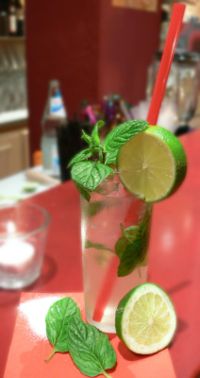Mojito
From Wikipedia, the free encyclopedia
| IBA Official Cocktail | |
|---|---|
 |
|
| Type | Cocktail |
| Primary alcohol by volume | |
| Served | On the rocks; poured over ice |
| Standard garnish | sprig of mint |
| Standard drinkware | Highball glass |
Mojito (IPA: /moʊˈhiːtoʊ/; Spanish pronunciation: [moˈxito]) is a traditional Cuban highball.
A mojito is traditionally made of five ingredients: white rum, sugar (traditionally sugar cane juice), lime, carbonated water, and mint.[1][2] Its combination of sweetness, refreshing citrus and mint flavors are intended to complement the potent kick of the rum, and have made this clear highball a popular summer drink.[3][4]
When preparing a mojito, lime juice is added to sugar (or syrup) and mint leaves. The mixture is then gently mashed with a muddler. The mint leaves should only be bruised to release the essential oils and must not be shredded.[5] Then rum is added and the mixture is briefly stirred to dissolve the sugar and to lift the mint sprigs up from the bottom for better presentation. Finally, the drink is topped with ice cubes and sparkling water, and mint leaves and lime wedges are used to garnish the glass.[6]
The mojito is one of the more famous rum-based highballs. There are several versions of the mojito.[7]
Contents |
[edit] Origin
Cuba is the birthplace of the mojito, although the exact origin of this classic cocktail is the subject of debate.[8] One story traces the mojito to a similar 16th century drink, the “El Draque,” in honor of Sir Francis Drake.[4] It was made initially with tafia/aguardiente, a primitive predecessor of rum, but as soon as rum became widely available to the British (ca. 1650) they changed it to rum. [4] Mint, lime and sugar were also helpful in hiding the harsh taste of this spirit. While this drink was not called a mojito at this time, it was still the original combination of these ingredients.
Some historians contend that African slaves that worked in the Cuban sugar cane fields during the 19th century were instrumental in the cocktail's origin.[8] Guarapo, the sugar cane juice often used in mojitos,[4] was a popular drink amongst the slaves who helped coin the name of the sweet nectar.[8]
There are several theories behind the origin of the name mojito, one such theory holds that name relates to mojo, a Cuban seasoning made from lime and used to flavour dishes.[4][9] Another theory is that the name mojito is simply a derivative of mojadito, Spanish for "a little wet", or simply the dimunitive of "mojado" (wet).[10]
[edit] Variations
- Many hotels in Havana also add Angostura bitters to cut the sweetness of the mojito; while a popular variation, it is not the original version created in La Bodeguita del Medio.[1]
- In some places in Cuba, dark or golden rums are used along with brown sugar to create a stronger and heavier version compared to the original version.[11]
- Whole lime wedges may be muddled in the bottom along with the mint and sugar, which are left in the drink.[5]
- Mojito sweetness can vary significantly. Icing sugar is often muddled with the mint leaves rather than cane sugar, and many establishments simply use sugar syrup to control sweetness.[12]
- Fruit flavored vodkas or rums are often substituted, such as mango, strawberry, lychee or mandarin mojitos.[3]
[edit] See also
| Wikimedia Commons has media related to: Mojito |
[edit] References
- ^ a b Traditional Mojito recipe from Cuba
- ^ About.com Mojito
- ^ a b Summer Cocktail News: Mojitos Go Fruity
- ^ a b c d e Shake It Up, Baby: Cuban Cocktail Is Making a Splash
- ^ a b How to Muddle a Mojito
- ^ The Classic Cuban Mojito
- ^ Cuban Mojito Recipe or American Mojito Recipe
- ^ a b c Mojito History
- ^ Mojito is derived from the Spanish mojo sauce, which often contains lime juice (see "mojito" at Dictionary.com, citing the American Heritage Dictionary of the English Language, Fourth Edition, 2006, Houghton Mifflin), while mojo is derived from the Spanish verb mojar, meaning, "to make wet" (see definition 3 of "mojo" at Dictionary.com, citing Webster's New Millennium Dictionary of English, Preview Edition (v 0.9.7), 2003-2007, Lexico Publishing Group, LLC)
- ^ Mojito & Apple-soaked Mojito
- ^ BBC: How to mix a Mojito
- ^ Food: Mojito - The Austin Chronicle
| The Wikibook Bartending has a page on the topic of |

